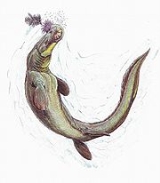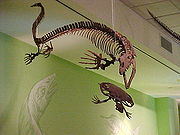
Mosasaurinae
Encyclopedia
Mosasaurinae is a subfamily of mosasaur
s, a diverse group of Late Cretaceous
marine squamates.
Russell (1967, pp. 123–124) defined the Mosasurinae as differing from all other mosasaurs as follows: "Small rostrum
present or absent anterior to premaxilla
ry teeth. Fourteen or more teeth present in dentary and maxilla
. Cranial nerves X, XI, and XII leave lateral wall of opisthotic through two foramina. No canal or groove in floor of basioccipital or basisphenoid for basilar artery. Suprastapedial process of quadrate
distally expanded. Dorsal edge of surangular thin lamina of bone rising anteriorly to posterior surface of coronoid...At least 31, usually 42–45 presacral vertebrae present. Length of presacral series exceeds that of postsacral, neural spines of posterior caudal vertebrae elongated to form distinct fin. Appendicular elements with smoothly finished articular surfaces, tarsus
and carpus
well ossified." In his 1997 revision of the phylogeny of the Mosasauroidea, Bell (pp. 293–332) retained the Mosasaurinae as a clade
, though he reassigned Russell's tribe Prognathodontini to the Mosasaurinae and recognized a new tribe of mosasaurines, the Globidensini.
 Genera
Genera
referrable to the Mosasaurinae ("mosasaurines") have been found on all continents except Australia and South America. The lineage first appears in the Turonian
and thrived until the mass extinction event at the end of the Maastrichtian
. They ranged in size from one of the smallest known mosasaurs (Carinodens, 3–3.5 meters), to medium-sized taxa (Clidastes, 6+ meters), to the largest of the mosasaurs (Mosasaurus
hoffamannii) reaching approximately 17 meters in length. Many genera of mosasaurines were either piscivorous or generalists, preying on fish
and other marine reptiles, but one lineage, the Globidensini evolved specialized crushing teeth, adapting to a diet of ammonite
s and/or marine turtle
s.
Mosasaur
Mosasaurs are large extinct marine lizards. The first fossil remains were discovered in a limestone quarry at Maastricht on the Meuse in 1764...
s, a diverse group of Late Cretaceous
Cretaceous
The Cretaceous , derived from the Latin "creta" , usually abbreviated K for its German translation Kreide , is a geologic period and system from circa to million years ago. In the geologic timescale, the Cretaceous follows the Jurassic period and is followed by the Paleogene period of the...
marine squamates.
Russell (1967, pp. 123–124) defined the Mosasurinae as differing from all other mosasaurs as follows: "Small rostrum
Rostrum (anatomy)
The term rostrum is used for a number of unrelated structures in different groups of animals:*In crustaceans, the rostrum is the forward extension of the carapace in front of the eyes....
present or absent anterior to premaxilla
Premaxilla
The incisive bone is the portion of the maxilla adjacent to the incisors. It is a pair of small cranial bones at the very tip of the jaws of many animals, usually bearing teeth, but not always. They are connected to the maxilla and the nasals....
ry teeth. Fourteen or more teeth present in dentary and maxilla
Maxilla
The maxilla is a fusion of two bones along the palatal fissure that form the upper jaw. This is similar to the mandible , which is also a fusion of two halves at the mental symphysis. Sometimes The maxilla (plural: maxillae) is a fusion of two bones along the palatal fissure that form the upper...
. Cranial nerves X, XI, and XII leave lateral wall of opisthotic through two foramina. No canal or groove in floor of basioccipital or basisphenoid for basilar artery. Suprastapedial process of quadrate
Quadrate bone
The quadrate bone is part of a skull in most tetrapods, including amphibians, sauropsids , and early synapsids. In these animals it connects to the quadratojugal and squamosal in the skull, and forms part of the jaw joint .- Evolutionary variation :In snakes, the quadrate bone has become elongated...
distally expanded. Dorsal edge of surangular thin lamina of bone rising anteriorly to posterior surface of coronoid...At least 31, usually 42–45 presacral vertebrae present. Length of presacral series exceeds that of postsacral, neural spines of posterior caudal vertebrae elongated to form distinct fin. Appendicular elements with smoothly finished articular surfaces, tarsus
Tarsus (skeleton)
In tetrapods, the tarsus is a cluster of articulating bones in each foot situated between the lower end of tibia and fibula of the lower leg and the metatarsus. In the foot the tarsus articulates with the bones of the metatarsus, which in turn articulate with the bones of the individual toes...
and carpus
Carpus
In tetrapods, the carpus is the sole cluster of bones in the wrist between the radius and ulna and the metacarpus. The bones of the carpus do not belong to individual fingers , whereas those of the metacarpus do. The corresponding part of the foot is the tarsus...
well ossified." In his 1997 revision of the phylogeny of the Mosasauroidea, Bell (pp. 293–332) retained the Mosasaurinae as a clade
Clade
A clade is a group consisting of a species and all its descendants. In the terms of biological systematics, a clade is a single "branch" on the "tree of life". The idea that such a "natural group" of organisms should be grouped together and given a taxonomic name is central to biological...
, though he reassigned Russell's tribe Prognathodontini to the Mosasaurinae and recognized a new tribe of mosasaurines, the Globidensini.

Genus
In biology, a genus is a low-level taxonomic rank used in the biological classification of living and fossil organisms, which is an example of definition by genus and differentia...
referrable to the Mosasaurinae ("mosasaurines") have been found on all continents except Australia and South America. The lineage first appears in the Turonian
Turonian
The Turonian is, in the ICS' geologic timescale, the second age in the Late Cretaceous epoch, or a stage in the Upper Cretaceous series. It spans the time between 93.5 ± 0.8 Ma and 89.3 ± 1 Ma...
and thrived until the mass extinction event at the end of the Maastrichtian
Maastrichtian
The Maastrichtian is, in the ICS' geologic timescale, the latest age or upper stage of the Late Cretaceous epoch or Upper Cretaceous series, the Cretaceous period or system, and of the Mesozoic era or erathem. It spanned from 70.6 ± 0.6 Ma to 65.5 ± 0.3 Ma...
. They ranged in size from one of the smallest known mosasaurs (Carinodens, 3–3.5 meters), to medium-sized taxa (Clidastes, 6+ meters), to the largest of the mosasaurs (Mosasaurus
Mosasaurus
Mosasaurus is a genus of mosasaur, carnivorous, aquatic lizards, somewhat resembling flippered crocodiles, with elongated heavy jaws. The genus existed during the Maastrichtian age of the Cretaceous period , around 70-65 millions years ago in the area of modern Western Europe and North America...
hoffamannii) reaching approximately 17 meters in length. Many genera of mosasaurines were either piscivorous or generalists, preying on fish
Fish
Fish are a paraphyletic group of organisms that consist of all gill-bearing aquatic vertebrate animals that lack limbs with digits. Included in this definition are the living hagfish, lampreys, and cartilaginous and bony fish, as well as various extinct related groups...
and other marine reptiles, but one lineage, the Globidensini evolved specialized crushing teeth, adapting to a diet of ammonite
Ammonite
Ammonite, as a zoological or paleontological term, refers to any member of the Ammonoidea an extinct subclass within the Molluscan class Cephalopoda which are more closely related to living coleoids Ammonite, as a zoological or paleontological term, refers to any member of the Ammonoidea an extinct...
s and/or marine turtle
Turtle
Turtles are reptiles of the order Testudines , characterised by a special bony or cartilaginous shell developed from their ribs that acts as a shield...
s.
Species and Taxonomy
- Subfamily Mosasaurinae
- DallasaurusDallasaurusDallasaurus is a basal mosasauroid from the Upper Cretaceous of North America. The genus is based upon two partial skeletons recovered from the Arcadia Park Shale , approximately 15 meters above its contact with the older Kamp Ranch Limestone in Dallas County in north-central Texas...
- Mosasaurini (Russell, 1967)
- ClidastesClidastesClidastes is an extinct genus of mosasaur lizard from marine environments of the Late Cretaceous.Clidastes was an agile and fast swimmer that cruised the surface or shallow waters hunting for fish, flying reptiles and anything that got too close.- Appearance :Clidastes was the smallest of the...
(paraphyletic)- C. liodontus
- C. "moorevilensis" (nomen nudumNomen nudumThe phrase nomen nudum is a Latin term, meaning "naked name", used in taxonomy...
) - C. propython
- MosasaurusMosasaurusMosasaurus is a genus of mosasaur, carnivorous, aquatic lizards, somewhat resembling flippered crocodiles, with elongated heavy jaws. The genus existed during the Maastrichtian age of the Cretaceous period , around 70-65 millions years ago in the area of modern Western Europe and North America...
(paraphyletic)- M. hoffmannii (=M. maximus)
- M. conodon
- M. dekayi
- M. missouriensis
- M. mokoroa
- MoanasaurusMoanasaurusMoanasaurus was a genus of mosasaur from the Late Cretaceous period. Its fossil remains have been discovered in the North Island of New Zealand. Moanasaurus was a very large mosasaurine known originally from a disarticulated skull, vertebrae, ribs and paddle bones...
- M. mangahouangae
- AmphekepubisAmphekepubisAmphekepubis is a genus of mosasaur from the Late Cretaceous of Mexico.-References:*-External links:*...
- A. johnsoni
- LiodonLiodonLiodon is a genus of mosasaur from the Late Cretaceous. Remains assigned to this genus have been found in Africa, Asia, Europe, America and South America, and New Zealand. It was first named by Richard Owen as Leiodon, but that name was already in use for a fish, necessitating the name...
(polyphyletic)- L. anceps
- L. sectorius
- L. mosasauroides
- Clidastes
- Plotosaurini (Russell, 1967)
- PlotosaurusPlotosaurusPlotosaurus is an extinct genus of mosasaur from the Upper Cretaceous of Fresno County, California. Originally named Kolposaurus by Berkeley paleontologist Charles Lewis Camp in 1942, it was changed to Plotosaurus in 1951 when Camp discovered the name had already been assigned to a type of...
- P. tuckeri
- P. bennisoni
- Plotosaurus
- Globidensini (Bell, 1997)
- GlobidensGlobidensGlobidens is an extinct genus of mosasaur lizard.Globidens alabamaensis was first described by Gilmore . A second species was described by Russell . The third North American species Globidens ("Globe teeth") is an extinct genus of mosasaur lizard.Globidens alabamaensis was first described by...
- G. alabamaensis
- G. dakotensis
- CarinodensCarinodensCarinodens is a genus of mosasaur. It was named in 1969 as a replacement for Compressidens, which was already in use for a mollusk. Measuring approximately in length, it is one of the smallest known mosasaurs. It is widely considered a sister taxon to Globidens. It also had round, blunt teeth for...
- C. belgicus
- PrognathodonPrognathodonPrognathodon is an extinct genus of marine reptile belonging to the mosasaur family. It had protective bony rings surrounding its eye sockets, indicating it lived in deep water. its fossil remains have been found in the U.S.A , Canada , Belgium, New Zealand, Morocco and The Netherlands...
- P. overtoni
- P. giganteus
- P. rapax
- P. waiparaensis
- P. stadtmani
- P. solvayi
- PlesiotylosaurusPlesiotylosaurusPlesiotylosaurus is a genus of mosasaur from the Maastrichtian stage of the Late Cretaceous of North America.-References:* Dinosaurs and Other Mesozoic Reptiles of California by Richard P. Hilton, Kevin Padian, and Ken Kirkland...
- P. crassidens
- Globidens
- Dallasaurus

